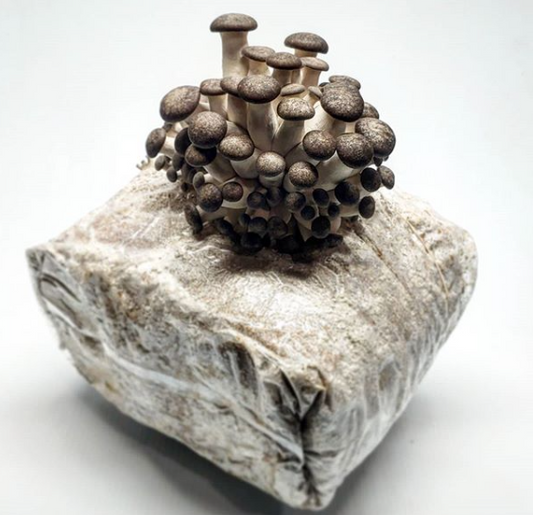Receiving mushroom spawn
- When you receive your mushroom spawn please check for any breaks in the bag or contamination, email or call us immediately if anything seems off. Mushroom grow kits come with a small hole slit in them but mushroom spawn is shipped completely sealed.
- It is best to use your mushroom spawn within a month of receiving it. Store mushroom spawn in the fridge until you are ready to use it. Plug spawn can last for over a year in the fridge while sawdust and grain spawn are usually good for 2-3 months. It is best to use mushroom spawn while it is fresh so within 1 month of receiving it.
- If you do not use the entire bag of mushroom spawn simply roll the top down and place a rubber band around the entire bag, put the bag in a bottom drawer of the fridge until you are ready to use it.
What is mushroom spawn?
Mushroom spawn is essentially the "seed" that is used to cultivate mushrooms. Mushroom spawn is any sort of material also known as "substrate" with mycelium grown on it. The mycelium is then planted or inoculated into a new substrate and leaps off, growing into the new home it has been placed in. Mushroom spawn comes in several different forms depending on what substrate you are growing on. Grain, sawdust, and plug spawn are the most common forms that are found.
Grain spawn is typically a lower generation and has a higher nutrient profile. This makes grain spawn a good option when the substrate will be further expanded or if you want to add additional nutrients into the substrate. For example grain spawn can be further expanded into more grain spawn or into a supplemented sawdust fruiting block. You can also inoculate straw or straight sawdust, adding additional nutrients into the substrate.
Sawdust spawn is the most common type of spawn used for outdoor mushroom production. Sawdust is usually the cheapest of the spawn options and has a relatively quick leap-off because of the small particle sizes. Since there is very little in the way of food reserves for the mycelium to eat, it rapidly looks for a new substrate to grow on. Sawdust spawn typically comes in 5-5.5 pound bags and costs $20-25. Our sawdust spawn is third generation. When inoculating logs, sawdust spawn requires a specialized tool called a palm inoculator. Because of this, sawdust is best used when inoculating 20+ logs for multiple years.
Plug spawn is mycelium grown out on birch furniture dowels. Our dowels are 5/16 in diameter and 1 inch long. Plug spawn is a good option for growers who are inoculating 20 or less logs each year. Getting 100 or 500 counts of plug spawn allows you to play with a variety of species and have a small amount of logs. Plugs are a little bit more expensive than sawdust spawn and take slightly longer to colonize.
The generations of mushroom spawn are very straight forward. The first substrate inoculated from a petri plate is usually grain and called Generation 1. This is then expanded 8-10x into more grain which is Generation 2 grain. From here we either sell the grain spawn or go to Generation 3 sawdust or plug spawn. Most growers do not transfer beyond 4 generations for fear of the strain losing vigor in fruiting, a phenomenon called strain senescence.
Strain selection is an essential part to mushroom cultivation. Strain refers to a unique individual within a species. I like to compare this to humans. All humans are in the species Homo sapiens. But only 1 is referred to as Willie Crosby with this particular set of genetic information. Likewise all shiitake fall under Lentinula edodes but there are distinct individuals that express their genetic information differently. Just like in humans, this allows a lot of variability in the traits that are expressed. In humans, things like eye color, hair color, and size are influenced by this genetic make up. In shiitakes, things like ornamentation on the cap, substrate it grows in, size of fruiting body, yield, and speed of incubation are all influenced by strain. As you can tell, those are all critical aspects to cultivating shiitakes. For many growers a strain that grows fast, has large fruiting bodies, and fruits abundantly is the ideal. With fast growth, the timeline from raw substrate to mushroom is faster and the chance for contamination decreases. Large fruiting bodies typically lead to better shelf life, better handling capacity, and less harvest time. Obviously increased yields are a great thing when combined with the first two. The trick then is to find a strain that embodies all these things in balance. We have spent the last 8 years trialing and testing strains, talking to other growers, and trading genetics to find the best strains for our customers.
In all trials and cultivation conducted at Fungi Ally, strain selection is always the first step. To decide the best strain it is great to
- Talk to other mushroom growers or grower networks
- Trial 3 or 4 strains in your particular operation to see which performs best
- Research what the standard strain in the industry is (be sure similar methods of cultivation are used)
- Talk to mushroom spawn providers about the strains they offer.
 Sold out
Sold out Sold out
Sold out





